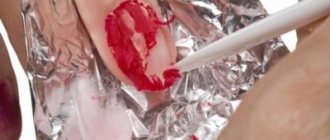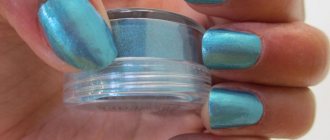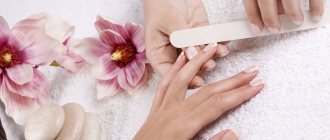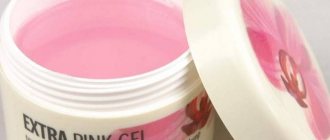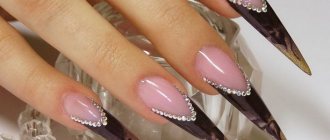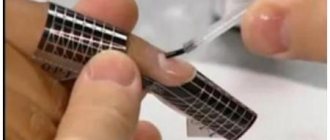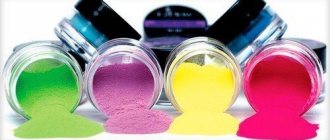How to replace acrylic powder
| What can replace acrylic powder? | Description |
| Gel | Since acrylic powder cannot be replaced by another substance due to its composition, you just have to choose a different method of nail extension. For this purpose, the nail industry uses gel. This is a synthetic material that is odorless and hardens under the influence of ultraviolet rays in an LED lamp. This material is completely safe for health, it is easy to give it the desired shape. The gel is quite plastic; when removing extended nails, you can leave a small layer of artificial coating on the nail plate to strengthen it, this will not be noticeable. |
| Acrygel | An innovative product that is actively used by manicurists and pedicurists today has been able to combine the qualities of acrylic and gel. This is a very durable and high-quality material that allows you to model extended nails of any length and shape. The presented product has many advantages:
This product does not contain a monomer, the characteristic smell of which is not liked by many women and the hairdressers themselves. In this regard, you don’t have to look for something to replace the monomer for acrylic powder; the applied product holds firmly even without it. Acrigel allows the master to easily model the desired nail shape. At the same time, they are quite thin, but very durable. Extended nails are almost identical to natural ones. The disadvantage of the proposed alternative product for many is its cost. Compared to acrylic it is much higher. |
Every woman wants to have beautiful and well-groomed hands, but sometimes at home it is not possible to find time for herself to get a beautiful manicure. An excellent solution in this case is nail extensions. The materials used by the craftsmen are highly durable, and the result looks neat and beautiful.
Acrylic is most often used for extensions. Not everyone likes or is suitable for this material, then the question arises as to what can replace acrylic powder.
In terms of composition, it has no analogues; you can only use a different material in the extension process.
Gel
An odorless synthetic material is a gel. It is increasingly used in nail extensions. It does not cause allergies and is completely safe for nails and health.
The presented alternative material has a lot of advantages; women and the nail industry masters themselves like it. Along with the advantages, the gel also has a number of certain disadvantages.
- With sudden temperature changes, the gel may begin to crack.
- The material cannot be removed at home using improvised means. The artificial coating is removed during the sawing process using a special nail file.
- If the extended nail is broken, it cannot be extended by half; it must be completely removed and the procedure done from the very beginning.
- In some cases, the gel can be rejected by the body - this often happens during pregnancy, menstruation, and other hormonal disorders. The same can happen with diabetes.
Acrigel
Often, allergies during the process of nail extensions are provoked by the liquid for acrylic powder, and not just by the material used itself. This problem was solved when beauty industry professionals were offered a new product - acrygel. It combines the characteristics of acrylic and gel. You no longer need to use a monomer to work with it.
Acrigel is applied in a thin layer, allowing you to model the desired shape and length of the nail. It is very durable and completely safe for health. Craftsmen like to work with acrygel; it does not spread and is highly plastic.
Is it worth getting your nails done?
Many people consider the disadvantage of extended nails to be that corrections need to be made periodically as the natural nail begins to grow.
It is important to consider that a number of materials used in extensions can shrink during wear. They can provoke rejection of the nail bed.
You need to know that acrylic is an allergen. In case of individual intolerance, it can cause an allergic reaction.
Acrylic powder used in the nail industry is durable, allowing artists to create real masterpieces on their nails. The proposed alternative options for replacing such material have advantages and disadvantages; you should choose based on personal preferences and the body’s reaction to the material.
chem-zamenit.ru
Acrigel
Often, allergies during the process of nail extensions are provoked by the liquid for acrylic powder, and not just by the material used itself. This problem was solved when beauty industry professionals were offered a new product - acrygel. It combines the characteristics of acrylic and gel. You no longer need to use a monomer to work with it.
Acrigel is applied in a thin layer, allowing you to model the desired shape and length of the nail. It is very durable and completely safe for health. Craftsmen like to work with acrygel; it does not spread and is highly plastic.
Monomer for nails: what is it and how to use it?
Many girls like to do nail extensions to get not only a beautiful manicure, but also to create an amazing design on long nails that will look impressive. Nail extensions cannot be done without monomer, so it’s worth taking a closer look at what it is and how to apply it correctly.
Nail monomer is one of the main components that is used for acrylic extensions. It is presented in the form of a liquid product, which, when interacting with acrylic powder, begins to harden. It is also commonly called liquidity.
Using this product, acrylic is applied quite easily, while the liquid does not affect the acrylic in terms of color changes, since it contains ultraviolet inhibitors. The monomer makes acrylic plastic, strong and durable, since it contains special plasticizers. Many nail industry professionals use monomer when working with multi-colored acrylic powders.
As you know, when applying gel extensions, a mandatory tool is a gel polish lamp, because it is with its help that the coating polymerization process occurs. Acrylic nail extensions occur without the use of this device, since the hardening process is carried out due to a chemical reaction when mixing acrylic powder and liquid. This method is characterized by convenience for many nail industry professionals. It avoids the cost of purchasing a lamp. In addition, there is no need to take it with you when visiting a client’s home.
Today, manufacturers of manicure products offer a wide range of monomers. They differ in different characteristics, thereby providing the opportunity to choose the most convenient option for each buyer.
When choosing, a master can take into account not only his skills in the nail field, but also the tasks that he sets for himself.
Nail monomers vary depending on the curing time of the material.
- For beginners, it is better when the product hardens gradually, because in this way you can correct shortcomings and not rush into the nail plate extension itself. You can forget about the rush and devote maximum effort to each nail. This option is ideal for acrylic sculpting.
- Masters in the field of nail extensions prefer monomers with an average hardening speed. This option is often used to create a three-dimensional design.
- True professionals in their field prefer to work exclusively with quick-hardening options. It is these monomers that guarantee excellent quality for a long time. The nail not only retains its color, it is not prone to yellowing prematurely. The master requires skills and high speed of work.
When choosing a monomer for nails, you should consider the following nuances:
- for a durable manicure, you should choose liquids that harden fairly quickly, then you can be sure that chips will definitely not appear on your nails;
- odorless liquids are on sale, which will become indispensable for customers with a heightened sense of smell;
- To make a French manicure, you should pay attention to special monomers that have a blue or purple tint; this tone will better emphasize the white color.
The choice of liquid should be made based on the quality of the composition. You should definitely familiarize yourself with the composition, because the product should not contain components that are harmful or dangerous to the body.
To extend nails, mix acrylic powder with liquid, then apply this mixture to the nail using a brush. The hardening time of the composition is on average two minutes. During this period, the master must not only apply the composition to the nail plate, but also distribute it evenly, creating a smooth surface. When the coating has hardened, you can proceed to adjusting the nails by filing. After this, a fixative should be applied to the nail plate.
When working with acrylic powder and liquid, there is no need to use special forms or containers. Everything is done quite simply - the brush is first dipped into the monomer, then into the powder. It is worth immersing not the entire brush, but only its tip, and all actions should be performed as carefully as possible. A small ball should form on the brush; it is this that is distributed over the nail plate. Its consistency should be viscous.
To learn how to work with monomer, see the following video.
vplate.ru
Acrylic and monomer from Impuls. How do I use them
Why do you need acrylic if you don’t know how to model nails with it?
That's right, use it to design and strengthen your nails. And how to do this is under the cut. Acrylic nail extensions appeared a long time ago, and still have ardent fans.
And there are reasons for this. Acrylic nails are much stronger than gel nails. Yes, there are now a lot of excellent gels that are almost as strong as acrylic, but acrylic is still acrylic. In Russia it is now not as widespread as the gel, but in America, for example, it is now very popular. Once you watch the master classes of foreign masters on acrylic design, you immediately realize how meager your imagination is) I have always liked acrylic nail design. All kinds of flowers, abstraction, voluminous brooches, animals... you can create a real masterpiece on your nails if you know how to hold the brush correctly and how to work on acrylic. But the trouble is that I don’t know how. I haven't taken any courses in acrylic design, but that doesn't stop me from using it in my daily work. For myself, I chose the following list of products: Impuls Acryl White
I use it both for design and to strengthen my nails.
In order to strengthen your nails, you do not necessarily need a monomer. The powder is applied in a thin layer to an undried base and polymerized in a lamp. Or it is mixed with a liquid base, and the resulting mixture is used to level the nail plate. I don’t use this method because I hardly work with liquid bases. Price 690 rubles 36 grams Rating 5 out of 5
Impuls Color Acryl Powder
Price 260 rubles 4 grams Rating 5 out of 5
The most important thing when using powders is monomer/liquid. Impuls Liquid Slow Violet
This is a liquid with a pungent odor and barely noticeable color, which starts the process of polymerization/hardening of acrylic, and turns it first into a plastic mass, and then into a solid, immobile one.
It has a slightly noticeable purple tint, which does not affect the color of the resulting mass.
Monomers come in fast and slow curing types. For experienced and inexperienced craftsmen. I took the second option, since I have little experience working with acrylic, and if you skip the plastic phase, a frozen ball of acrylic will remain on the nail and that’s it) I made the right choice, since I have time to finish the design, and even sometimes make adjustments if something doesn’t suit me arranges. Price 750 rubles Volume 120 ml Rating 5 out of 5
And now photos of the resulting design options.
The nail is sprinkled with acrylic powder with glitter, and a design is made on top.
The snowflake and three-dimensional design on top are sprinkled with white acrylic powder.
Increase
WHAT TO REPLACE A BRANDED ACRYLIC THINNER
Preface:
Most modern acrylic paints can be thinned with water.
But introducing only water into the paint is accompanied by a fairly rapid decrease in viscosity.
The best results are observed when the paint is diluted with a thinning varnish or its mixture with water.
For example, with the introduction of 10–15% weakening varnish (acrylic water-based varnish diluted by 10–15% with distilled water), the viscosity of the paint changes slowly, there is no change in the shade of the paint, and resistance to abrasion and scraping, resistance to fats, paraffin and other substances is higher than when using only water as a diluent.
This is especially important when using water-based paints where the technological features of the application method require a stronger dilution of the paints (and the increased phonation and foaming that appears when over-diluting with water only, deterioration in the strength characteristics of the paint layer, etc. are an additional incentive to use a varnish-attenuator) .
Now the specifics:
Most commercial acrylic paint THINNERS do not consist of a pure substance, but of at least two components: a thinner and a retarder. Sometimes there is a third component: a pigment binder (varnish). Their THINNER for acrylic paint is a 60-65% solution of isopropyl alcohol in distilled water containing approximately 7% propylene glycol.
Here the solvent is isopropyl alcohol and the retarder is propylene glycol. A retarder is needed to ensure that the composition does not dry out too quickly; it slows down evaporation, and at the same time improves the spreading of paint. If it weren’t for it, the paint would have dried in the airbrush and would have clumped. If you set out to make an analogue of a standard branded THINNER for acrylic, propylene glycol can be replaced, for example, with glycerin. The result will be the same. It is important that the water is demineralized (distilled), since otherwise the salts can increase or decrease that same polarity with poorly predictable results. It should also be noted that commercial solvents for indoor use most often use non-toxic (mildly toxic) substances.
An acrylic solvent consisting of a 60% solution of (poisonous) methyl alcohol with the addition of (also poisonous) ethylene glycol would work no worse (even better), but using it in your work is a sure path to blindness.
At worst, you can use ethylene glycol instead of propylene glycol (it is contained in brake fluid), but this is not recommended - it is better to find glycerin.
Attention!!!
I have already said that the active ingredient in the acrylic solvent is isopropyl alcohol (isopropanol).
So, under no circumstances use pure 96% isopropanol as a solvent.
Not only does it evaporate in seconds, it is many times more effective at dissolving ANY paint.
With a little pressure, isopropanol washes off nitro enamels (which are in cans) after several days of drying, and easily removes ordinary enamels and any acrylic paints.
Only 2-component paints with a hardener after complete polymerization are resistant to absolute isopropanol.
=============================================================
xn--h1afdfbaeasmui9j.xn--p1ai
Unscented acrylic nail extensions - Is it possible to have unscented nail extensions?
2017-08-14 13:36:23 Author: Beauty editor Anna 5054
Acrylic nail modeling is a separate direction in the nail industry, allowing the master to fully unleash his creative potential thanks to the use of modern polymer materials. Provided the master is highly professional, the result of the work will be flawless nails that are durable and look as natural as possible, regardless of the client’s initial data. The variety of acrylic materials and the rich range of colored acrylics for volumetric designs impresses with the enormous possibilities in the artistic design of nails using a variety of techniques in work.
Is it possible to have odorless nail extensions?
The principle of acrylic nail extension is based on the chemical reaction of finely ground acrylic powder from uniformly pigmented polymer particles and a special liquid - a monomer, which acts as a direct catalyst. The advantage of acrylic modeling is that the master does not need UF and LED equipment to carry out the procedure, since the material polymerizes in air within a few minutes without additional influences. However, despite this, the type of nail design so popular among clients is not so often used by manicurists and novice amateurs at home? The fact is that not everyone easily tolerates the pungent odor that is characteristic of most professional monomers. Unfortunately, odorless acrylic modeling technology is not yet available today, and all existing odorless analogs have a number of imperfections and, therefore, are not in demand among customers. The efforts of the largest companies in the nail industry are aimed at developing an odorless liquid, or reducing its intensity in existing monomer liquids. Read more: Instructions for acrylic nail extensions
Odorless monomer
The quality of the finished acrylic, the product of the interaction of acrylic polymer powder and monomer liquid, depends on the quality of these two materials. In professional acrylic powder, all fine particles must be of different sizes in order to fill the modeled layer as densely as possible. A high-quality liquid must have a certain composition and concentration capable of catalyzing a strong chemical reaction to form a high-quality, homogeneous acrylic ball. Some companies have changed the molecular formula of existing products and released the desired odorless monomers, but practitioners immediately noticed the main disadvantages of the material:
- The resulting acrylic nails resulting from the use of odorless monomer become completely unstable to any solvents, due to which their wear resistance is significantly reduced.
- If ordinary acrylic nails, if necessary, can be coated with any nail polish and then wiped off without visible consequences for the surface of the artificial acrylic nail, then the use of odorless liquid in modeling eliminates this possibility. Due to the high content of acetone (essentially a solvent) in nail polish, the surface of the acrylic coating immediately loses its glossy texture and may crack.
- The odorless liquid does not allow you to create voluminous color designs, since the acrylic ball is not dense enough and self-levels when applied to the nail plate. Needless to say, creating an aquarium effect with such material is quite difficult.
That is why, when choosing materials for work, first read the reviews of real craftsmen who have already used miracle monomers of the brand you are interested in in their work. In the meantime, several recommendations will help you come to terms with this inconvenience on how to eliminate discomfort from the smell of liquid during the nail modeling procedure.
Ways to eliminate unpleasant monomer odor
- It is advisable to carry out the acrylic nail modeling procedure in a well-ventilated room with fully opening windows. This will allow the smell of monomer to disappear after each client and prevent its accumulation in things and pieces of furniture.
- If you do not have the opportunity to regularly ventilate the room (there are no windows), then a mandatory measure is to install a powerful hood directly above the manicurist’s workplace, which will significantly reduce the smell of monomer in the office.
- Many manufacturers of nail products have added special fragrances for monomers to their range, which can slightly eliminate the pungent odor. They can be added to the liquid before use in the recommended proportions, but this may deteriorate the properties of the monomer.
- Special glass containers with a volume of 20-30 ml. in the form of mini cups with a glass lid included, which closes tightly while the master is working with the monomer. This way you can not only minimize the intensity of liquid evaporation, but also prevent the loss of basic properties.
- When working with acrylic material, the master should use only professional brushes for nail modeling (do not correct the shape of the nail with your fingers). Excess monomer is carefully removed from brushes only with special lint-free wipes.
- Rubber gloves are a mandatory way to protect the technician’s hands from getting monomer on the skin of the hands.
In fact, today an odorless acrylic monomer is not the most important problem for an actively practicing nail technician. After all, modern liquids do not contain the prohibited methyl ether, which has a detrimental effect on the human body if inhaled regularly. In the modern monomer formula, this component is replaced by ethyl ether. It is more important to protect yourself from dust from sawdust getting into your respiratory tract and eyes with the help of special glasses and a respirator mask.
kodi-professional.ru
